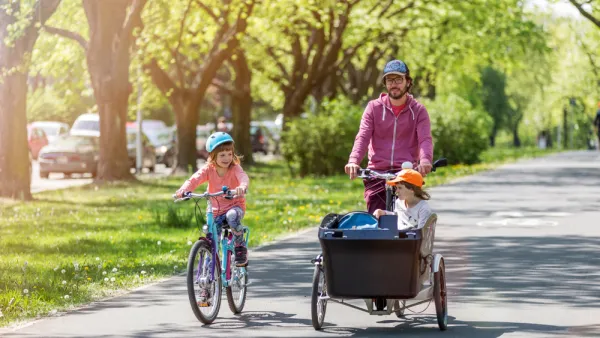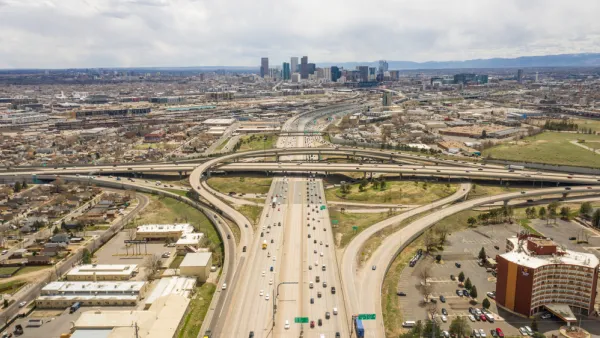The U.S. Census Bureau estimates that in 2007, over 9.8 million American households had no auto available at home. Although those car free households make up only 8.7% of the U.S., the split by housing ownership is striking: only 3.3% of owner occupied homes do without at least one vehicle, where fully 19.9% of renters have no cars parked in the proverbial driveway. For some, not owning a vehicle is not a matter of choice -- just the reality of limited resources. For others, it's a matter of preference, and many residents of cities with fairly good public transportation choosing to go without cars. Although car ownership is a useful indicator of neighborhoods that provide good options for public transit, the reality is the most important variable isn't whether you own one, but how much you drive. That's the idea behind the annual Car-Free Challenge sponsored by the San Francisco Bay Area nonprofit TransForm (formerly TALC - Transportation and Land Use Coalition). The Challenge's over 160 participants pledged to drive less than 125 miles in June, much less than the Bay Area average of 540, or the U.S. average of over 1,000. Many participants contributed blog posts about their experiences on the Challenge website. More than just a group of footloose young professionals living in The Mission, challenge participants were remarkably diverse group living mostly in the Bay Area but also Sacramento, Los Angeles, and cities outside of California.
The U.S. Census Bureau estimates that in 2007, over 9.8 million American households had no auto available at home. Although those car free households make up only 8.7% of the U.S., the split by housing ownership is striking: only 3.3% of owner occupied homes do without at least one vehicle, where fully 19.9% of renters have no cars parked in the proverbial driveway.
For some, not owning a vehicle is not a matter of choice -- just the reality of limited resources. For others, it's a matter of preference, and many residents of cities with fairly good public transportation choosing to go without cars. Although car ownership is a useful indicator of neighborhoods that provide good options for public transit, the reality is the most important variable isn't whether you own one, but how much you drive.
That's the idea behind the annual Car-Free Challenge sponsored by the San Francisco Bay Area nonprofit TransForm (formerly TALC - Transportation and Land Use Coalition). The Challenge's over 160 participants pledged to drive less than 125 miles in June, much less than the Bay Area average of 540, or the U.S. average of over 1,000. Many participants contributed blog posts about their experiences on the Challenge website. More than just a group of footloose young professionals living in The Mission, challenge participants were remarkably diverse group living mostly in the Bay Area but also Sacramento, Los Angeles, and cities outside of California.
As expected, many of the posts illustrate just how limited our public transit options are, and just how different the city is to experience without a car. One participant observed an 11 mile trip in San Jose took an hour and a half by transit -- and they didn't even miss a connection. Kirsten Gronfield, an actress in Burbank, was frustrated to find the best way to take transit to the Dodgers game ten miles away was also an hour and a half bus ride. Some found the challenge was enjoyable, finding they enjoyed the exercise and unexpected pleasures of walking or biking. One mother, traveling late at night on the BART with two small children and her mother found it resulted in additional quality family time, and the opportunity to bump into a friend.
Through surveys and complicated computer models, planners attempt to estimate our preferences for driving when provided alternative modes. Although there may be important market distortions at play, the overall pattern of auto dependence is undeniable. A growing body of evidence is developing that shows urban form -- and the quality of transit available -- can change people's habits. However, these changes are expensive, controversial, difficult and require decades to fully implement.
Although physical form is important, travel patterns are fundamentally based on millions of decisions made by regular people each day. These decisions can change when prices fluctuate, the city form or transit changes, or, like this group of 160 intrepid participants, people decide to change their behavior. On this point, Berkeley teenager and Car-Free Challenge participant Lang Miller can provide us some perspective.
A member of her school's Mountain Bike Team (this is California, after all), Lang didn't think twice about joining the car free challenge. "When my parents were my age they lived out in the 'burbs and had to drive to get places," she writes, "but my generation has watched An Inconvenient Truth in class and had school projects on carbon emissions. ... We are of a newer and more educated generation, and have been taught that cars are not entirely necessary to our existence." If she's right, the result could be quite different statistics indeed.

National Parks Layoffs Will Cause Communities to Lose Billions
Thousands of essential park workers were laid off this week, just before the busy spring break season.

Retro-silient?: America’s First “Eco-burb,” The Woodlands Turns 50
A master-planned community north of Houston offers lessons on green infrastructure and resilient design, but falls short of its founder’s lofty affordability and walkability goals.

Delivering for America Plan Will Downgrade Mail Service in at Least 49.5 Percent of Zip Codes
Republican and Democrat lawmakers criticize the plan for its disproportionate negative impact on rural communities.

Test News Post 1
This is a summary

Test News Headline 46
Test for the image on the front page.

Balancing Bombs and Butterflies: How the National Guard Protects a Rare Species
The National Guard at Fort Indiantown Gap uses GIS technology and land management strategies to balance military training with conservation efforts, ensuring the survival of the rare eastern regal fritillary butterfly.
Urban Design for Planners 1: Software Tools
This six-course series explores essential urban design concepts using open source software and equips planners with the tools they need to participate fully in the urban design process.
Planning for Universal Design
Learn the tools for implementing Universal Design in planning regulations.
EMC Planning Group, Inc.
Planetizen
Planetizen
Mpact (formerly Rail~Volution)
Great Falls Development Authority, Inc.
HUDs Office of Policy Development and Research
NYU Wagner Graduate School of Public Service






























